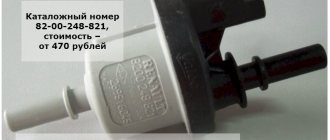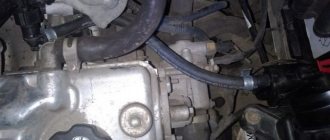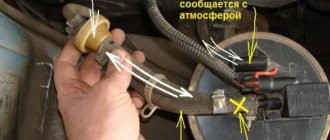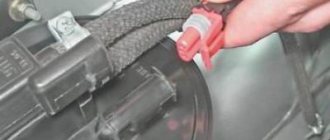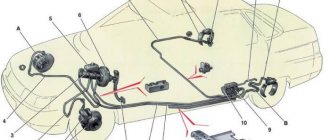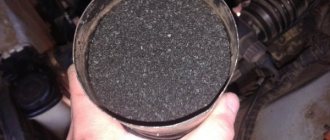The thought of removing the adsorber lingered in my head for a long time, but I still couldn’t get around to it, but after I decided to get into the braid that goes to the mounting block, I decided to get around to it, even changing a regular idle speed sensor took a lot of work.
So, we go to the store and buy 2 clamps (for the hose in the throttle and for the fine filter), a fine filter (I took the cheapest one, because there is no point in buying an expensive one) and a regular self-tapping bolt, whatever comes to hand.
Let's get down to business, first of all I removed the spacer, then use a 10mm wrench to loosen the bolt that tightens the adsorber body itself, then remove the adsorber by disconnecting the hoses and the connector to the sensor.
Having taken out the adsorber, we need to remove the sensor from it so that the check engine does not constantly light up, the sensor itself can be attached to something with plastic clamps, I have it attached to the 3rd support of the air filter near the battery.
Next, we cut off the hose that goes to the throttle and insert a bolt into it and tighten it with a clamp. On the 2nd hose from the gas tank we put a fine filter, tighten it with a clamp and hide it in some place (mine is next to the mounting block)
Adsorber, a term coined from English, denoting a part of a vehicle responsible for absorbing combustion products by liquid (solid) bodies in a special container. The VAZ 2114 adsorber (some call it an absorber) uses activated carbon as an absorbing element, which is what the domestic model is filled with.
The adsorber is a complex mechanical joint, sold and installed on the car, according to the kit, from the following elements:
- the adsorber itself;
- purge valve;
- gravity valve;
- vapor separator;
- tubes: steam line, valve, adsorber;
- fuel drain pipe;
- additional hoses.
Purpose and principle of operation of the adsorber purge valve
Absorber valve diagram
The EVAP system is installed on gasoline internal combustion engines to prevent fuel vapors from entering the atmosphere. The canister purge solenoid valve is an element of this system. Therefore, to find out what the canister valve is for and how it works, it is important to understand the operating principle of the entire system. The design of the adsorber is a container filled with an adsorbent, most often activated carbon. The device is connected to the fuel tank and the control valve of the vehicle using special tubes.
The canister valve is installed between the intake manifold and the canister and performs the function of ventilation.
Gasoline vapors formed in the fuel tank penetrate the separator, where they condense and are discharged back into the tank. Some of the vapor does not have time to condense in the separator and enters the adsorber through the steam line. In the filter system, they are absorbed by activated carbon, accumulated and then supplied to the intake manifold when the engine starts. The process of absorption of fuel vapors takes place only when the engine is turned off. When the car is running, the electronic control unit opens the canister purge solenoid valve, through which air enters and thus ventilation occurs. In this case, the accumulated condensate along with air is sucked out of the adsorber and again enters the engine, where it is burned out. The canister valve provides ventilation to the entire mechanism and directs fuel condensate back to the engine.
Brief information
Adsorption is the process of absorption of one substance (more rarefied) by another (more dense)
. In this case, the transformation of one chemical substance into another does not occur. This principle finds application in various spheres of human life - from medicine to industry.
The following are used as absorbent substances:
- A carbon-containing substance of organic origin that has pores;
- Dried gel;
- Calcium and sodium aluminosilicates;
- Various minerals found in the natural environment.
Starting from the second generation of the Euro series environmental standard, all manufactured cars must have a special capacity to absorb gasoline or diesel fumes. European manufacturers who flout these rules are fined. Foreign violating factories are losing the European market.
The absorber is a small cylindrical container located under the hood of the car in close proximity to the engine.
Car enthusiasts often make a mistake in spelling the word “adsorber”
, replacing the letter “d” with “b”. The erroneous option is very common, but adsorber is still normative .
Malfunctions of the adsorber valve and their elimination
Almost continuous operation of the fuel vapor absorption system canister can cause damage to the purge valve. A malfunction of the canister valve often leads to damage to the fuel pump. Due to poor ventilation of the adsorber, gasoline accumulates in the intake manifold, the engine loses power, and fuel consumption gradually increases. This may cause the engine to stop completely. The operation of the entire vehicle depends on how the adsorber valve works.
How to check the functionality of the canister purge valve?
Checking the absorber valve
In order to notice and correct problems in time, regular checks of the adsorber valve are necessary. In this case, a breakdown can be identified by certain indirect signs. When the engine is idling or in cold weather, the vapor absorption system makes characteristic sounds, like the canister valve clicking. Some people confuse this sound with a faulty timing belt, rollers or other parts. You can check this by sharply pressing the gas pedal. If the sound has not changed, it means the canister valve is clicking. Experts can explain what to do if the canister valve knocks too loudly. To do this, you need to tighten the adjusting screw, and first it is cleared of epoxy resin.
The absorber valve can be adjusted.
The screw turns approximately half a turn. If you tighten it too much, the controller will generate an error. This adjustment of the adsorber valve will make its operation softer and the knocking noise quieter. However, how to check the adsorber valve for damage? Valve failure can be determined using an error diagnostic system or mechanical testing. Electronic error codes are stored in the controller's memory and indicate electrical damage. To check the valve, it is recommended to pay attention to errors generated by the controller, such as “open circuit of the canister purge valve control circuit.” Signs by which a malfunction of the adsorber valve can be mechanically determined:
- The appearance of dips at idle speed of the engine.
- Very low engine thrust.
- There is no sound of valve operation when the engine is running.
- A hissing sound when the gas tank cap is opened indicates a vacuum in the system. This is a sure sign of a malfunction in the adsorber ventilation.
- The appearance of a fuel smell in the car interior. However, its appearance can also be caused by other reasons.
Determining possible damage
How to remove scratches on car glass?
We have figured out why the adsorber is needed, now let’s determine the signs indicating its failure. Considering the quality of fuel at gas stations in our homeland, this part often becomes dirty and fails.
Any malfunction of this mechanism can be easily determined by obvious signs:
Damage to the absorber - the fact that this mechanism of your car has problems can be determined by hearing a hissing sound when opening the tank, it indicates the accumulation of an excess amount of gasoline vapor.
Excessive pressure appears in the tank when you open the lid, there is a moment when the contact area with the external environment is small, and the pressure is quickly “relieved” through it, and the tank “hisses”, similar to a bottle of soda.
In the event of a breakdown, the adsorber is often removed completely, we will discuss how to do this below, but there are no unnecessary parts in the car, it is worth remembering. If you don’t want to remove and gut the ECU, you can try to fix everything yourself. The weakest point in the absorption kit is the VAZ 2114 valve.
Before repairing, you need to make sure that the problem is here:
- Use a flat-head screwdriver to unscrew the fastener on the motor cover (be careful, the fastener is plastic, you shouldn’t break it), and then very carefully remove the clamps.
- We remove the part and blow out the valve. If air does not pass through, then the valve is operational, and the breakdown is elsewhere; if air passes through the valve, then you have found the problem.
A valve failure, in addition to unstable idle speed, will soon give you CheckEngine and significantly increased consumption.
Do-it-yourself absorber valve replacement
If signs of malfunction are detected, the valve will need to be repaired or replaced. The adsorber valve is inexpensive and easy to replace. To dismantle you need to have a pair of Phillips screwdrivers and know where the canister purge valve is located. Operating procedure:
The markings on the old and new valves must match.
- Open the hood and find a cylindrical device - an adsorber.
- Remove the negative terminal from the battery.
- Disconnect the wire block by pressing the latch and pulling it towards you.
- Loosen the valve.
- Remove the fittings under the latch and disconnect the hoses.
- Remove the valve together with the bracket from the adsorber.
- The new valve is installed in the reverse order.
Useful video
You can get additional information about the design of the adsorber and options for replacing it from the video below:
Why is an adsorber installed on a car? This is a fairly popular question among owners of domestic cars. The device appeared immediately after the introduction of the Euro-3 environmental standard.
The device itself is a black cylinder, which is installed in the right corner of the engine compartment, next to the radiator. In fact, this is an adsorber, the principle of operation of which we will consider in this article.
How does the Lada Kalina gasoline vapor recovery system work?
The EVAP system in question was created to prevent the release of harmful gasoline vapors into the surrounding atmosphere resulting from fuel evaporation; it includes:
- fuel shut-off valve;
- adsorber;
- solenoid valve for purging the absorbent element;
- connecting pipelines.
The most important component in the system is the adsorber (also called a carbon filter), the basis of which is activated non-edible carbon, enclosed in a plastic housing. The resulting gasoline vapors are absorbed by the carbon of the absorbent element, gradually accumulating in it. When the engine starts, the canister purge valve (KPA) is turned on, and due to the vacuum, all accumulated vapors enter the intake manifold and then burn out.
On the Lada Kalina, the adsorber is located in the gas tank area, and getting to it is very difficult. To dismantle this EVAP element, it is necessary to remove the fuel tank, but the control unit is located in an accessible place - the valve is located in the engine compartment, in close proximity to the battery, on the rear wall of the air filter housing. It should be noted that for turbocharged engines, a vacuum is not created in the intake manifold, and in order to force the vapors in the desired direction, an additional two-way valve is included in the circuit.
Where is it installed?
As a rule, the adsorber is installed under the hood on the right in the direction of travel of the car, for example, in the VAZ 2110 it has the shape of a barrel.
In other cars, it may be square and installed to the left of the engine (in the direction of travel), under the air duct (Lada Granta), the vacuum brake booster (some Nissan models) or in the radiator area. In the VAZ 2114 it is located next to the battery and air filter.
On the Volkswagen Passat B3, the adsorber is located under the air filter on the right side in the direction of travel.
Other vehicles: Refer to model owner's manual.
Design of the VAZ Kalina adsorber purge valve
KPA is present on all modern injection internal combustion engines, and Lada Kalina is also no exception. The purge valve (another name is Evap-Solenoid) is connected on one side to the carbon filter, on the other to the intake manifold, when there is no electrical signal to the control unit, the pipeline channel is closed, and vacuum is not created in the system. When an electrical signal is supplied while the engine is running, the valve is activated, the channel opens, and gasoline vapors freely pass from the adsorber into the intake manifold.
Diagnostics of gas tank ventilation (EVAP system)
Vita-Motors diagnosticians , in accordance with the identified system trouble codes (DTC - diagnostic trouble codes), will perform tests and verification procedures in accordance with the manufacturer's technical bulletins. EVAP diagnostic work includes such procedures as: checking the functionality of solenoids, ventilation valves, pressure and vacuum sensors of the EVAP system and other elements of the tank ventilation system. After checking the electrical components and actuators of the system, diagnostic work is carried out to check the air (vacuum) lines for integrity (leaks). To connect the vacuum pump, Smoke Pro ® smoke generator and other special equipment, use the diagnostic line connector or (if it is not available) the tank filler neck. Upon completion of the diagnosis, the client is given a list of detected faults, which indicates the spare parts and labor required to eliminate the defect. If in the process of troubleshooting it is possible to eliminate a minor defect or recalibrate the system (as a result of which it will be possible to get rid of the annoying problem), then this work will be included in the cost of the diagnosis.
If the test is impossible due to damage to communications (digital buses/CAN bus, power, etc.), Vita-Motors technicians will offer the client to first restore the information highway, and only then will diagnose the EVAP system.
The EVAP system on modern cars is one of the most important engine management systems, connected to other systems (fuel supply, ignition, etc.), which is why about fifty fault codes are “assigned” to the ventilation system in the on-board diagnostic system (On-Board). Board Diagnostic system – OBD-II). If earlier the entire “system” (and it was not yet called a system) was just a tube connected to the atmosphere for the normal operation of the fuel pump (to avoid excessive vacuum in the system and, as a result, crumpling of the gas tank), now the EVAP system is This is a complex mechanism with processor control and software, which includes the following elements:
- EVAP canister purge solenoid
- EVAP canister
- Fluid level vent valve
- Vapor recirculation tube
- Fuel fill neck and fill cap
- Fuel tank
- EVAP canister vent valve
- Vent hose/pipe
- EVAP vapor tube
- EVAP purge tube
- EVAP service port or service access connector
Malfunctions in the fuel vapor recovery system Lada Kalina
Since the solenoid valve itself is not a complex device, it has few malfunctions as such - it may not open or close when necessary, or may freeze in a certain position. But the culprit of the breakdown may not only be Evap-Solenoid; the gasoline vapor recovery system does not work correctly for other reasons:
- connecting pipes are pinched or clogged;
- normal vacuum is not created in the system;
- due to an open circuit, there is no voltage on the valve;
- the carbon filter is completely clogged (which is rare);
- The control unit malfunctions.
If the CPA is stuck in the open position and does not block the channel, the following defects may occur:
- the fuel mixture becomes richer, causing “blackness” to appear on the electrodes of the spark plugs;
- the engine begins to operate unstably, this is especially noticeable at idle;
- gasoline consumption increases;
- The throttle response of the internal combustion engine decreases.
When the EVAP channel is constantly blocked by the purge valve, excess vapor pressure is created in the gas tank, due to this:
- there is a risk of fuel pump failure;
- The fuel level sensor may fail.
It should be noted that purge occurs in a certain mode after starting the engine, the program is executed depending on the crankshaft speed, and the system does not work at idle. An impulse arrives at the CPA if:
- the coolant has heated to a temperature of at least 75 degrees Celsius;
- the throttle valve is open at least 4%;
- the car is moving at a speed of more than 10 km/h (but this is not a necessary condition).
Main signs of air leaks
Most often, air leaks from a car engine are manifested by the following symptoms:
- Problems with starting after a long period of parking (for example, in the morning).
- Reduced power. On power units with an air flow meter, the idle speed drops, and on engines with an absolute pressure sensor (MAP sensor), the speed, on the contrary, increases (diagnostic errors on the oxygen sensor, misfires and a lean mixture also appear).
- Unstable operation at idle - the tachometer needle constantly twitches, and at low speeds the engine may stall. In cars with a carburetor engine, the quantity and quality of the mixture is practically impossible to adjust, since air enters in excess volume.
- Increased fuel consumption - to start and continue driving, the driver is forced to maintain high speeds without switching to higher speeds.
Replacing the adsorber purge valve on Kalina
If the check shows that the Evap-Solenoid is faulty, the part must be replaced (catalog number - 11181164200). There is no point in repairing the device:
- the price of the valve is in the range of 400-800 rubles;
- You can buy the device in almost any store that sells VAZ spare parts;
- changing the KPA is very easy and simple.
But before making a replacement, it would be a good idea to check the control circuit; quite often the valve does not work due to a break in the wires going to it. To complete the work, you will not need a pit or a lift, and the procedure itself will take no more than one to two hours, even if the operation is performed by an inexperienced worker without metalworking skills.
We change the valve as follows:
- turn off the ignition, raise the hood;
- find Evap-Soleno />
- We dismantle the valve together with the tube, and the disassembly is almost complete.
Replacing the purge valve could be considered a very simple task, if not for one “but” - it is very difficult to remove the plastic tube from the CPA without damaging it, and it does not come with the new valve. There are two options here:
- try to carefully heat the connection with a hairdryer and pull off the pipe;
- cut the tube at the connections, and instead buy an ordinary fuel hose with a diameter of 8 mm and two clamps.
Having measured the required length of the hose, cut it, connect it to the valve and connector, we get approximately the same design as in the figure below.
We install everything in place, start the engine, and test the car on the move.
The adsorber valve is knocking on Kalina
Many owners of Lada Kalina cars are faced with a problem - while the engine is running, an incomprehensible clattering sound is heard from under the hood; when identifying the cause of the noise, it turns out that the sound comes from the purge valve. Although the knocking does not affect the operation of the car in any way, some car owners are annoyed by it, and car owners want to get rid of it. You can “overcome” the unpleasant clattering sound; you just need to do the following:
- remove the valve and inspect it carefully;
- Find the adjusting screw on the side; it will be filled with epoxy resin on top;
- pick out the epoxy, tighten the screw half or three-quarters of a turn;
- install the valve in place, check for changes in the operation of the internal combustion engine.
You cannot tighten the screw any more, in this case the control panel will stop opening, and the engine diagnostic lamp on the instrument panel will record an error. It is also worth noting that some drivers confuse the clatter of the solenoid valve with detonation, but in principle, the sounds can be distinguished. You just need to take into account that detonation occurs under load, for example, when a loaded car is moving uphill, in this case they say “fingers are ringing.”
How did I remove it then?
I simply removed everything related to the adsorber from the firmware and “brains”. In fact, the system itself does not work for me and the computer no longer focuses on the operation of these mechanisms, thereby allowing the engine to work normally.
These are just my basic assumptions. Those who don’t want to do this can simply try changing the purge valve, but since I have a non-standard motor with EURO-0
, I decided to take a radical approach to this.
Source
Error P0441
Owners of Lada Kalina often note that during the operation of the car, error P0441 appears, indicating that the gasoline vapor purge system is not operating correctly (the air flow differs from the norm). The cause of this malfunction may be:
- inoperative adsorber valve;
- clogging of the air line from the control unit to the air filter;
- air leakage through connecting pipes.
What should not be immediately considered is the line from the gas tank to the adsorber; here, a breakdown does not in any way affect the readings of the computer or diagnostic scanner. Still, most often Evap-Solenoid fails; this is a characteristic “disease” on Kalina.
If the EVAP valve stops functioning normally, it is not at all necessary that the engine will lose power, the fuel pump will fail, and so on. Mainly due to problems with the control gear, exhaust toxicity increases, and the Check Engine on the dashboard periodically lights up. There are car owners who do not pay attention to the diagnostic warning light, continuing to operate the car, but do not experience any great inconvenience. And most often in such a case, gasoline consumption does not exceed the norm, the engine starts normally, and no serious problems occur in the fuel system.
